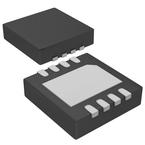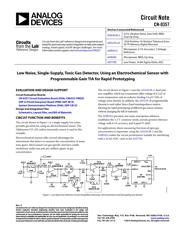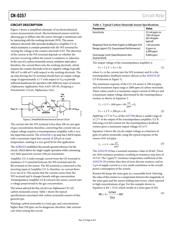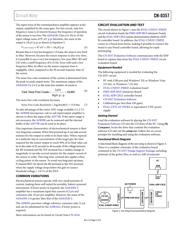Datasheet 搜索 > 运算放大器 > ADI(亚德诺) > ADA4528-1ACPZ-R7 数据手册 > ADA4528-1ACPZ-R7 用户编程技术手册 2/5 页

 器件3D模型
器件3D模型¥ 17.5
ADA4528-1ACPZ-R7 用户编程技术手册 - ADI(亚德诺)
制造商:
ADI(亚德诺)
分类:
运算放大器
封装:
LFCSP-8
描述:
ANALOG DEVICES ADA4528-1ACPZ-R7 运算放大器, 单路, 3.4 MHz, 1个放大器, 0.5 V/µs, 2.2V 至 5.5V, ± 1.1V 至 ± 2.75V, LFCSP, 8 引脚
Pictures:
3D模型
符号图
焊盘图
引脚图
产品图
页面导航:
原理图在P1P3
技术参数、封装参数在P2
导航目录
ADA4528-1ACPZ-R7数据手册
Page:
of 5 Go
若手册格式错乱,请下载阅览PDF原文件

CN-0357 Circuit Note
Rev. 0 | Page 2 of 5
CIRCUIT DESCRIPTION
Figure 2 shows a simplified schematic of an electrochemical
sensor measurement circuit. Electrochemical sensors work by
allowing gas to diffuse into the sensor through a membrane and
by interacting with the working electrode (WE). The sensor
reference electrode (RE) provides feedback to Amplifier U2-A,
which maintains a constant potential with the WE terminal by
varying the voltage at the counter electrode (CE). The direction
of the current at the WE terminal depends on whether the
reaction occurring within the sensor is oxidation or reduction.
In the case of a carbon monoxide sensor, oxidation takes place;
therefore, the current flows into the working electrode, which
requires the counter electrode to be at a negative voltage (typically
300 mV to 400 mV) with respect to the working electrode. The
op amp driving the CE terminal should have an output voltage
range of approximately ±1 V with respect to V
REF
to provide
sufficient headroom for operation with different types of sensors
(Alphasense Application Note AAN-105-03, Designing a
Potentiostatic Circuit, Alphasense, Ltd.).
CE
–
+
SENSOR
V
REF
V
OUT
V
REF
I
WE
I
WE
I
WE
RE
WE
RF
12332-002
Figure 2. Simplified Electrochemical Sensor Circuit
The current into the WE terminal is less than 100 nA per ppm
of gas concentration; therefore, converting this current into an
output voltage requires a transimpedance amplifier with a very
low input bias current. The ADA4528-2 op amp has CMOS inputs
with a maximum input bias current of 220 pA at room
temperature, making it a very good fit for this application.
The ADR3412 establishes the pseudo ground reference for the
circuit, which allows for single-supply operation while consuming
very little quiescent current (100 µA maximum).
Amplifier U2-A sinks enough current from the CE terminal to
maintain a 0 V potential between the WE terminal and the
RE terminal on the sensor. The RE terminal is connected to the
inverting input of Amplifier U2-A; therefore, no current flows
in or out of it. This means that the current comes from the
WE terminal and it changes linearly with gas concentration.
Transimpedance Amplifier U2-B converts the sensor current into
a voltage proportional to the gas concentration.
The sensor selected for this circuit is an Alphasense CO-AX
carbon monoxide sensor. Table 1 shows the typical
specifications associated with carbon monoxide sensors of this
general type.
Warning: carbon monoxide is a toxic gas, and concentrations
higher than 250 ppm can be dangerous; therefore, take extreme
care when testing this circuit.
Table 1. Typical Carbon Monoxide Sensor Specifications
Parameter Value
Sensitivity 55 nA/ppm to
100 nA/ppm
(65 nA/ppm
typical)
Response Time (t
90
from 0 ppm to 400 ppm CO) <30 seconds
Range (ppm) CO, Guaranteed Performance) 0 ppm to
2,000 ppm
Overrange Limit (Specifications Not
Guaranteed)
4,000 ppm
The output voltage of the transimpedance amplifier is
V
O
= 1.2 V + I
WE
× R
F
(1)
where I
WE
is the current into the WE terminal, and R
F
is the
transimpedance feedback resistor (shown as the AD5270-20
U3-B rheostat in Figure 1).
The maximum response of the CO-AX sensor is 100 nA/ppm,
and its maximum input range is 2000 ppm of carbon monoxide.
These values result in a maximum output current of 200 μA and
a maximum output voltage determined by the transimpedance
resistor, as shown in Equation 2.
F
O
RV ×
×+=
ppm
nA
100
ppm2000V
2.1
V
O
= 1.2 V + 200 µA × R
F
(2)
Applying 1.2 V to V
REF
of the AD7790 allows a usable range of
±1.2 V at the output of the transimpedance amplifier, U2-B.
Selecting a 6.0 kΩ resistor for the transimpedance feedback
resistor gives a maximum output voltage of 2.4 V.
Equation 3 shows the circuit output voltage as a function of
ppm of carbon monoxide, using the typical response of the
sensor of 65 nA/ppm.
ppm
μV
390V2.1 +=
O
V
(3)
The AD5270-20 has a nominal resistance value of 20 kΩ. There
are 1024 resistance positions, resulting in resistance step sizes of
19.5 Ω. The 5 ppm/°C resistance temperature coefficient of the
AD5270-20 is better than that of most discrete resistors, and its
1 µA of supply current is a very small contributor to the overall
power consumption of the system.
Resistor R4 keeps the noise gain at a reasonable level. Selecting
the value of this resistor is a compromise between the magnitude of
the noise gain and the sensor settling time errors, when exposed
to high concentrations of gas. For the example shown in
Equation 4, R4 = 33 Ω, which results in a noise gain of 183.
183
Ω33
kΩ6.0
1 =+=NG
(4)
器件 Datasheet 文档搜索
AiEMA 数据库涵盖高达 72,405,303 个元件的数据手册,每天更新 5,000 多个 PDF 文件





